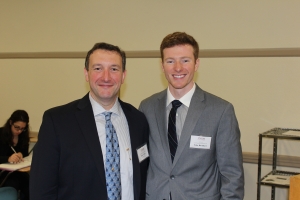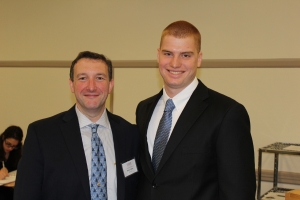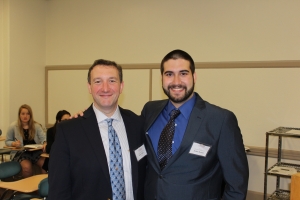Tyler Barnhart
An Investigation into Signaling by the Human Follicle Stimulating Hormone Receptor Through Receptor Mutagenesis
 Follitropin, also known as follicle stimulating hormone (FSH), carries out the reproductive regulation instructions of the endocrine system by binding to the follicle stimulating hormone receptor (FSHR). This promotes maturation of follicles in females and stimulates the production of sperm-stabilizing protein in males. The structure of FSHR is that of a typical G-protein-coupled receptor (GPCR) with 7 transmembrane domains. It resides on the cell membrane and has been shown to exist in membrane microdomains known as lipid rafts. Residency in lipid rafts is thought to enhance signal transduction by allowing for ‘scaffolding’ to sequester signaling components at the site of potentially active receptors. An amino acid sequence in the structure of FSHR known as a caveolin interaction motif (CIM) is hypothesized to allow the receptor to directly interact with caveolin. Four aromatic residues with a spacing of φXφXXXXφXXφ characterize the CIM structure. In order to determine whether the CIM is an integral part of FSHR function, we attempted to mutate the phenylalanines in the motif sequence to leucines. We hope to observe a non-functioning FSHR (or one with decreased efficacy) and thus further our understanding of GPCR signaling.
Follitropin, also known as follicle stimulating hormone (FSH), carries out the reproductive regulation instructions of the endocrine system by binding to the follicle stimulating hormone receptor (FSHR). This promotes maturation of follicles in females and stimulates the production of sperm-stabilizing protein in males. The structure of FSHR is that of a typical G-protein-coupled receptor (GPCR) with 7 transmembrane domains. It resides on the cell membrane and has been shown to exist in membrane microdomains known as lipid rafts. Residency in lipid rafts is thought to enhance signal transduction by allowing for ‘scaffolding’ to sequester signaling components at the site of potentially active receptors. An amino acid sequence in the structure of FSHR known as a caveolin interaction motif (CIM) is hypothesized to allow the receptor to directly interact with caveolin. Four aromatic residues with a spacing of φXφXXXXφXXφ characterize the CIM structure. In order to determine whether the CIM is an integral part of FSHR function, we attempted to mutate the phenylalanines in the motif sequence to leucines. We hope to observe a non-functioning FSHR (or one with decreased efficacy) and thus further our understanding of GPCR signaling.
Megan Dondarski
Human Follicle Stimulating Hormone Receptor (hFSHR) Signaling is Membrane Cholesterol and Internalization Dependent
 Human follicle stimulating hormone (hFSH) is a glycoprotein secreted by the anterior pituitary that is essential for reproduction. Its receptor (hFSHR) is a G protein-coupled receptor expressed on the surface of granulosa cells in females and Sertoli cells in males. FSH stimulates the maturation of ovarian follicles in females and triggers sperm production in males. Based on previous research in our lab, we proposed that hFSHR resides in lipid rafts on the cell membrane and that its signaling is cholesterol and internalization dependent. To test this hypothesis, we treated HEK-293 cells stably transfected with human FSHR cDNA or physiologically relevant immortalized human granulosa cells with the cholesterol depleting compound methyl-beta-cyclodextrin (MBCD) or the compound Nystatin which alters the cell membrane by sequestering cholesterol. Western blotting was used to measure the phosphorylation of map kinase p42/44. MBCD did not alter FSH dependent activation of p44/42, but a decrease in activation was observed when the cells were treated with Nystatin. These results suggest that FSHR signaling is dependent not on cholesterol alone, but also on internalization, which is blocked by Nystatin. This adds to an increasing body of evidence for multivalent hFSHR signaling with the possibility of selective modulation of the pathways.
Human follicle stimulating hormone (hFSH) is a glycoprotein secreted by the anterior pituitary that is essential for reproduction. Its receptor (hFSHR) is a G protein-coupled receptor expressed on the surface of granulosa cells in females and Sertoli cells in males. FSH stimulates the maturation of ovarian follicles in females and triggers sperm production in males. Based on previous research in our lab, we proposed that hFSHR resides in lipid rafts on the cell membrane and that its signaling is cholesterol and internalization dependent. To test this hypothesis, we treated HEK-293 cells stably transfected with human FSHR cDNA or physiologically relevant immortalized human granulosa cells with the cholesterol depleting compound methyl-beta-cyclodextrin (MBCD) or the compound Nystatin which alters the cell membrane by sequestering cholesterol. Western blotting was used to measure the phosphorylation of map kinase p42/44. MBCD did not alter FSH dependent activation of p44/42, but a decrease in activation was observed when the cells were treated with Nystatin. These results suggest that FSHR signaling is dependent not on cholesterol alone, but also on internalization, which is blocked by Nystatin. This adds to an increasing body of evidence for multivalent hFSHR signaling with the possibility of selective modulation of the pathways.
Tyler Esposito
Localization of the Follicle-Stimulating Hormone Receptor in Lipid Rafts
 Follicle-stimulating hormone (FSH) is a protein hormone secreted by the anterior pituitary which signals to the ovaries in women and the testes in men where it will bind to its G protein-coupled receptor (FSHR). FSH and its receptor are necessary for proper gamete maturation in both sexes. The hypothesis for this project was that FSHR is localized to lipid raft domains on the cell membrane. Lipid raft domains are thought to be important for the compartmentalization and the rapid response ability of G-protein coupled receptors. A putative raft marker, cholera toxin B subunit (CTB), was used because it selectively binds to lipid raft domains. This allowed for fluorescent staining of lipid raft domains and the follicle stimulating hormone receptor on the same cells. This staining was carried out on hGrC1 cells in the presence or absence of FSH. In hormone treated cells there was distinct colocalization of the two fluorescent signals, which was visualized using confocal microscopy. There was noticeably less overlap without hormone treatment. This result supports the hypothesis that lipid rafts are important for signaling through the follicle-stimulating hormone receptor.
Follicle-stimulating hormone (FSH) is a protein hormone secreted by the anterior pituitary which signals to the ovaries in women and the testes in men where it will bind to its G protein-coupled receptor (FSHR). FSH and its receptor are necessary for proper gamete maturation in both sexes. The hypothesis for this project was that FSHR is localized to lipid raft domains on the cell membrane. Lipid raft domains are thought to be important for the compartmentalization and the rapid response ability of G-protein coupled receptors. A putative raft marker, cholera toxin B subunit (CTB), was used because it selectively binds to lipid raft domains. This allowed for fluorescent staining of lipid raft domains and the follicle stimulating hormone receptor on the same cells. This staining was carried out on hGrC1 cells in the presence or absence of FSH. In hormone treated cells there was distinct colocalization of the two fluorescent signals, which was visualized using confocal microscopy. There was noticeably less overlap without hormone treatment. This result supports the hypothesis that lipid rafts are important for signaling through the follicle-stimulating hormone receptor.
Jordan Pereira
Interaction of Human Follicle Stimulating Hormone Receptor with Caveolin-1
 The human FSH receptor is a g protein-coupled receptor (GPCR) expressed on the surface of granulosa cells in the ovary and Sertoli cells in the testes. FSHR has a sequence of amino acids consistent with a caveolin interaction motif (FXFXXXXFXXF) found between amino acids 479-489 in the primary receptor sequence in the putative 4th transmembrane domain. Caveolin is a protein found in cell membrane microdomains such as lipid rafts. These densely packed regions of the membrane are enriched for sphingolipids and cholesterol and are thought to be involved in signal transduction. Caveolin can be found in caveolae, flask-like structures which are a specific type of lipid raft, or in non-caveolae lipid rafts. Although the receptor has this motif, it was unknown if hFSHR biochemically interacted with caveolin. To test this hypothesis, hFSHR was isolated by immunoprecipitiation from HEK-293 cells stably transfected with hFSHR cDNA. Analysis by western blot of co-immunoprecipitated proteins revealed the presence of caveolin-1. Together these results suggest that caveolin-1 plays an important role in cell signaling by sequestering hFSHR into lipid rafts for normal receptor function.
The human FSH receptor is a g protein-coupled receptor (GPCR) expressed on the surface of granulosa cells in the ovary and Sertoli cells in the testes. FSHR has a sequence of amino acids consistent with a caveolin interaction motif (FXFXXXXFXXF) found between amino acids 479-489 in the primary receptor sequence in the putative 4th transmembrane domain. Caveolin is a protein found in cell membrane microdomains such as lipid rafts. These densely packed regions of the membrane are enriched for sphingolipids and cholesterol and are thought to be involved in signal transduction. Caveolin can be found in caveolae, flask-like structures which are a specific type of lipid raft, or in non-caveolae lipid rafts. Although the receptor has this motif, it was unknown if hFSHR biochemically interacted with caveolin. To test this hypothesis, hFSHR was isolated by immunoprecipitiation from HEK-293 cells stably transfected with hFSHR cDNA. Analysis by western blot of co-immunoprecipitated proteins revealed the presence of caveolin-1. Together these results suggest that caveolin-1 plays an important role in cell signaling by sequestering hFSHR into lipid rafts for normal receptor function.
Catherine Tjan
Investigating The Human Follicle Stimulating Hormone And Its Receptors Using Atomic Force Microscopy
 Composed of the brain and other organs, the endocrine system maintains homeostasis in the human body through hormone regulation. One hormone involved in regulating sexual maturation and development is follicle stimulation hormone (hFSH). This hormone acts through a cell surface receptor to carry out its effects on target cells. In order to learn more about hFSHR and its presence in the cell membrane, an Atomic Force Microscope (AFM) was used to image the surface of the cell and to track hFSH receptors. Of particular interest is to measure membrane stiffness in the region where the receptors are located to determine if the receptors are in specific microdomains known as lipid rafts. To obtain cell images the cells were grown on plates coated with an agent to stop them from moving during imaging. Using these adherent cells, force curves can be generated, which will allow us to locate the lipid rafts using differences in the curves. Through a different mode of the AFM called tapping mode, we can use an antibody-modified tip to track of the proteins at a molecular scale resolution.
Composed of the brain and other organs, the endocrine system maintains homeostasis in the human body through hormone regulation. One hormone involved in regulating sexual maturation and development is follicle stimulation hormone (hFSH). This hormone acts through a cell surface receptor to carry out its effects on target cells. In order to learn more about hFSHR and its presence in the cell membrane, an Atomic Force Microscope (AFM) was used to image the surface of the cell and to track hFSH receptors. Of particular interest is to measure membrane stiffness in the region where the receptors are located to determine if the receptors are in specific microdomains known as lipid rafts. To obtain cell images the cells were grown on plates coated with an agent to stop them from moving during imaging. Using these adherent cells, force curves can be generated, which will allow us to locate the lipid rafts using differences in the curves. Through a different mode of the AFM called tapping mode, we can use an antibody-modified tip to track of the proteins at a molecular scale resolution.
David Wood
Investigating the Colocalization of the Follicle Stimulating Hormone Receptor with Caveolin in Lipid Rafts
 Upon activation, a cascade of signaling events is transduced from the follicle stimulating hormone receptor (FSHR) to the inside of a cell. These signals are involved in the reproductive system, and are therefore very important to human health. It is not known where on the cell membrane FSHR is found and subsequently activated; our hypothesis is that it is localized to lipid-rich structures called lipid rafts. Lipid rafts are highly organized domains on the cell membrane where much signal transduction takes place. Using fluorescent tagged caveolin (a protein found predominantly in lipid rafts) the rafts can be visualized under a microscope. Human granulosa cells naturally containing FSHR were transfected with fluorescent caveolin, then stained with a fluorescent antibody to the FSHR allowing both caveolin and FSHR to be visualized simultaneously. Colocalization of the 2 fluorescent signals demonstrated that these proteins are closely related spatially on the cell membrane and may in fact interact. Understanding this will give us greater insight into how this hormone receptor transduces signals and stimulates overall reproduction.
Upon activation, a cascade of signaling events is transduced from the follicle stimulating hormone receptor (FSHR) to the inside of a cell. These signals are involved in the reproductive system, and are therefore very important to human health. It is not known where on the cell membrane FSHR is found and subsequently activated; our hypothesis is that it is localized to lipid-rich structures called lipid rafts. Lipid rafts are highly organized domains on the cell membrane where much signal transduction takes place. Using fluorescent tagged caveolin (a protein found predominantly in lipid rafts) the rafts can be visualized under a microscope. Human granulosa cells naturally containing FSHR were transfected with fluorescent caveolin, then stained with a fluorescent antibody to the FSHR allowing both caveolin and FSHR to be visualized simultaneously. Colocalization of the 2 fluorescent signals demonstrated that these proteins are closely related spatially on the cell membrane and may in fact interact. Understanding this will give us greater insight into how this hormone receptor transduces signals and stimulates overall reproduction.
Research Practicum Students
- Allyson Staats
- Sara Zeltsman
- Jack Steinharter
Scholars Research Students
- Adam Bender
- Evan Leibovitz

You must be logged in to post a comment.